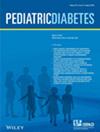2006-2008年和2017-2019年加拿大儿童2型糖尿病、药物性糖尿病和单基因糖尿病的发病率趋势
IF 3.9
3区 医学
Q2 ENDOCRINOLOGY & METABOLISM
引用次数: 0
摘要
介绍。儿童糖尿病的情况已经发生了变化,解决非1型糖尿病的知识差距是准确诊断的关键。目标。2006年至2008年期间完成了一项全国监测研究,然后在2017年至2019年期间重复了一项研究,以描述加拿大非1型糖尿病的发病率趋势和临床特征。方法。我们前瞻性地追踪了2017年6月1日至2019年5月31日期间18岁儿童非1型糖尿病的新病例。对于每个报告的新病例,都要完成一份详细的问卷调查,并将病例分类为2型糖尿病、药物诱导糖尿病(MID)、单基因糖尿病或“不确定”。计算非1型糖尿病及其亚型的最低发病率和10年发病率趋势。结果:共纳入非1型糖尿病441例(2型糖尿病332例;Mid = 52;单基因糖尿病= 30;不确定= 27)。与10年前相比,MID和单基因糖尿病的发病率保持稳定,而2型糖尿病的发病率增加了60% (p <在女性和男性中分别减少37% (p = 0.005)和50% (p = 0.001)。土著居民2型糖尿病发病率增加了1.5倍(p <0.001),在亚洲儿童中翻倍(p = 0.003)。结论。加拿大儿童期2型糖尿病的发病率显著增加。需要进一步的研究、政策和预防措施来遏制青少年2型糖尿病发病率的上升。本文章由计算机程序翻译,如有差异,请以英文原文为准。
Incidence Trends of Type 2 Diabetes Mellitus, Medication-Induced Diabetes, and Monogenic Diabetes in Canadian Children, Then (2006–2008) and Now (2017–2019)
Introduction. The landscape of childhood diabetes has evolved and addressing the knowledge gaps in non-Type 1 diabetes mellitus are key to accurate diagnosis. Objectives. A national surveillance study was completed between 2006 and 2008 and then repeated between 2017 and 2019 to describe Canadian incidence trends and clinical characteristics of non-Type 1 diabetes mellitus. Methods. We prospectively tracked new cases of non-Type 1 diabetes mellitus in children <18 years of age between June 1, 2017 and May 31, 2019. For each reported new case, a detailed questionnaire was completed, and cases were classified as Type 2 diabetes mellitus, medication-induced diabetes (MID), monogenic diabetes, or “indeterminate.” Minimum incidence rates and 10-year incidence trends of non-Type 1 diabetes mellitus and its subtypes were calculated. Results. 441 cases of non-Type 1 diabetes mellitus were included (Type 2 diabetes mellitus = 332; MID = 52; monogenic diabetes = 30; indeterminate = 27). Compared to 10 years ago, the incidence of MID and monogenic diabetes remained stable, while Type 2 diabetes mellitus increased by 60% ( ) overall and by 37% ( ) and 50% ( ) in females and males, respectively. Type 2 diabetes mellitus incidence increased by 1.5 times in Indigenous ( ) and doubled in Asian ( ) children. Conclusions. Canadian incidence rates of childhood-onset Type 2 diabetes mellitus have significantly increased. Further research, policy, and prevention efforts are needed to curb rising rates of youth onset Type 2 diabetes mellitus.
求助全文
通过发布文献求助,成功后即可免费获取论文全文。
去求助
来源期刊

Pediatric Diabetes
医学-内分泌学与代谢
CiteScore
6.60
自引率
14.70%
发文量
141
审稿时长
4-8 weeks
期刊介绍:
Pediatric Diabetes is a bi-monthly journal devoted to disseminating new knowledge relating to the epidemiology, etiology, pathogenesis, management, complications and prevention of diabetes in childhood and adolescence. The aim of the journal is to become the leading vehicle for international dissemination of research and practice relating to diabetes in youth. Papers are considered for publication based on the rigor of scientific approach, novelty, and importance for understanding mechanisms involved in the epidemiology and etiology of this disease, especially its molecular, biochemical and physiological aspects. Work relating to the clinical presentation, course, management and outcome of diabetes, including its physical and emotional sequelae, is considered. In vitro studies using animal or human tissues, whole animal and clinical studies in humans are also considered. The journal reviews full-length papers, preliminary communications with important new information, clinical reports, and reviews of major topics. Invited editorials, commentaries, and perspectives are a regular feature. The editors, based in the USA, Europe, and Australasia, maintain regular communications to assure rapid turnaround time of submitted manuscripts.
 求助内容:
求助内容: 应助结果提醒方式:
应助结果提醒方式:


